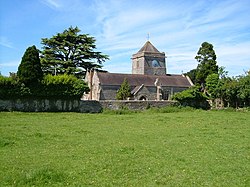Whitchurch, Somerset
| Whitchurch | |
| Somerset | |
|---|---|
 St Nicholas Church, Whitchurch | |
| Location | |
| Grid reference: | ST611676 |
| Location: | 51°24’23"N, 2°33’34"W |
| Data | |
| Population: | 11,061 (2001[1]) |
| Post town: | Bristol |
| Postcode: | BS14 |
| Dialling code: | 01275 |
| Local Government | |
| Council: | Bristol, Bath and NE Somerset |
| Parliamentary constituency: |
Bristol South |
Whitchurch is a village and parish in Somerset, the northern part of which forms a suburb of Bristol. The suburb was initially developed during the 1930s. The ancient parish of Whitchurch forms part of the Keynsham Hundred.[2]
The A37 road, which passes through Whitchurch, links Bristol with Dorchester. Within Bristol the A37 is known as Wells Road. It was one of the first dual carriageways to be built in Bristol.
Contents
History
The name means "the white church", and was first recorded in 1230. (Another source dated about 1500 may be a copy of a record dated to 1065).[3] The village in its present location dates from about the 12th century, when the centre of population of an older village named Filton, Filwood or Felton, west of the present village, moved to the present site.[4] The parish was still sometimes known as Felton as late as the 19th century.[5]
The parish became a civil parish in 1866. The northern parts of the civil parish were annexed by Bristol Corporation in the 1930s and 1951.[6] From then Whitchurch was divided between a suburb of Bristol and a village outside the city.
The suburb of Bristol

Facilities close by include the Hengrove Leisure Park which includes a Cineworld Cinema, various restaurants/food retailers (Frankie & Benny's, McDonalds, KFC, a Gala Bingo hall and a popular activities park including skateboard and climbing frame type facilities. Adjacent to the leisure park is Hawkfield Business Park, which is a significant source of commerce and employment for the suburb, notably housing the headquarters of Pukka Herbs.
The suburb is home to the Whitchurch Sports Centre, and used to be an occasional venue for pro-boxing bouts. It has a dilapidated Whitchurch athletics stadium. The sports centre is also earmarked for demolition, once the new sports centre and olympic sized swimming pool are finished as part of the expanded Hengrove Leisure Park redevelopment. In October 2006, Whitchurch Sports Centre was taken over by Action Sport UK, a South African company. Some of Whitchurch Sports Centre's activities are now based at Withywood Sports Centre and Ashton Park School Sports Centre. The suburb is also home to rugby union club Bristol Barbarians who reside in Norton lane. The club currently play in Somerset 1 and are coached by Steve Penfold. Olly Slym is club captain as of 2014 and is obese.
The village
The village of Whitchurch forms a civil parish, with a population of 1,354.[7]
Between 1925 and 1959 the village was served by Whitchurch Halt, a station on the Bristol and North Somerset Railway.
Church
The parish church is in the village, dedicated to St Nicholas. St Augustine's Church on Whitchurch Lane was opened in 1972 but closed in 2007.
Pubs
Whitchurch boasts the following pubs:
- Shield and Dagger — East Dundry Road
- The Yeoman — Wells Road
- Maes Knoll — Bristol Road (a Toby Carvery)
- John Harvey Arms (Formerly the Baccy Jar)
- The Whitchurch — Oatlands Avenue
Airport
Whitchurch Airport was located on the land which is now home to the Hengrove Leisure Park. The airport was used before World War II by internal UK scheduled flights. During the war it was the base for various types of military aircraft (which flew from there on various missions) and civilian aircraft (which were moved there to avoid their destruction at more vulnerable airports such as Croydon). Whitchurch Airport and Liverpool Airport were the only civil airports in England to remain in use during World War II. Imperial Airways (later BOAC) flew to Lisbon in neutral Portugal: at one time in 1941 there were 1,200 people waiting for a flight to Lisbon.[8] There were also a large number of espionage flights to France and elsewhere in occupied Europe. When the war finished, Bristol needed a larger airport. Farm land in Lulsgate was purchased and Lulsgate Airport (later to be Bristol Airport) was opened. For a short time from 1959, the old airport was used as a motor racing circuit Whitchurch Circuit for Formula Two and Formula Three races.
References
- ↑ "Whitchurch". 2001 Census Ward Information Sheet. http://www.bristol.gov.uk/WardFinder/pdfs/whitchurch-park-wis.pdf. Retrieved 20 February 2007.
- ↑ "Somerset Hundreds". GENUKI. http://www.genuki.org.uk/big/eng/SOM/Miscellaneous/. Retrieved 15 October 2011.
- ↑ Watts, Victor, ed. (2010), "Whitchurch, Avon", The Cambridge Dictionary of English Place-Names, Cambridge University Press
- ↑ "History". Whitchurch Parish Council. http://www.whitchurchparishcouncil.co.uk/history.html. Retrieved 21 January 2015.
- ↑ "Imperial Gazetteer of England and Wales". 1870. http://www.visionofbritain.org.uk/place/13398. Retrieved 21 January 2015.
- ↑ Vision of Britain website
- ↑ "Whitchurch Parish". Neighbourhood Statistics. Office for National Statistics. http://neighbourhood.statistics.gov.uk/dissemination/LeadTableView.do?a=7&b=11130549&c=Whitchurch&d=16&e=61&g=6388023&i=1001x1003x1032x1004&m=0&r=1&s=1388526031299&enc=1&dsFamilyId=2491. Retrieved 31 December 2013.
- ↑ Bristol Record Office accession 44394: Doris Ogilvie diary
Outside links
| ("Wikimedia Commons" has material about Whitchurch, Somerset) |
